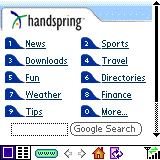 Blazer 3.0 is a completely new web browser, based on ACCESS' NetFront 3.0 core browser technology. It is standards compliant, and can now render frames, HTML 4.0, CSS, and even simple JavaScript. It also is proxy less, which has both good and bad parts to it. The interface is much the same as in Blazer 2.0, but with added benefit of the 5-way navigator, it is much easier to browse websites.
Blazer 3.0 is a completely new web browser, based on ACCESS' NetFront 3.0 core browser technology. It is standards compliant, and can now render frames, HTML 4.0, CSS, and even simple JavaScript. It also is proxy less, which has both good and bad parts to it. The interface is much the same as in Blazer 2.0, but with added benefit of the 5-way navigator, it is much easier to browse websites.
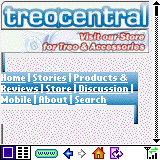
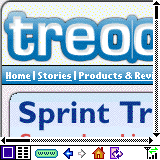 There are two ways to browse, optimized mode, and wide page mode. Optimized mode breaks tables and resizes images to fit on the screen. This is the best way to view websites on the Treos low resolution screen. Wide page mode is useful for some sites, but with the Treos low-resolution screen is very hard to use. (Lets just say that it requires a lot of scrolling!).
There are two ways to browse, optimized mode, and wide page mode. Optimized mode breaks tables and resizes images to fit on the screen. This is the best way to view websites on the Treos low resolution screen. Wide page mode is useful for some sites, but with the Treos low-resolution screen is very hard to use. (Lets just say that it requires a lot of scrolling!).
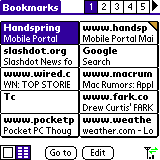 You can have 100 Bookmarks in Blazer. Bookmarks can also be saved pages, where the page is actually downloaded and stored on the Treo. Bookmarks can be added by pressing menu-A on a webpage, or by manually entering the webpage and a name for it in bookmarks view. There are few preferences for Blazer 3.0. A homepage can be set and one can choose to show images or not. An advanced tab goes into management of cached pages and the space that they can take.
You can have 100 Bookmarks in Blazer. Bookmarks can also be saved pages, where the page is actually downloaded and stored on the Treo. Bookmarks can be added by pressing menu-A on a webpage, or by manually entering the webpage and a name for it in bookmarks view. There are few preferences for Blazer 3.0. A homepage can be set and one can choose to show images or not. An advanced tab goes into management of cached pages and the space that they can take.
Blazer 3.0 is generally faster than earlier versions thanks to a combination of faster download speeds and a better processor to render pages with. A key bottleneck in rendering web pages is the downloading of images. Before, Handspring servers would retrieve pages for Blazer 2.0, resize the images and send them to the Treo. Now, that Blazer 3.0 is proxy less, the entire image must be downloaded onto the Treo 600 before it can resize the image. How this affects the browsing experience depends on the site, but in general image heavy sites can be slower, while text sites load faster than ever. 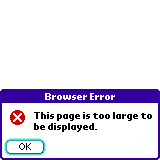 Another problem is that some sites error out saying this site is too large to be displayed. However, the part of the site that was downloaded is still shown after the error, so the importance of this is little.
Another problem is that some sites error out saying this site is too large to be displayed. However, the part of the site that was downloaded is still shown after the error, so the importance of this is little.
A cool (and long awaited) new feature of Blazer 3.0 is the ability to download applications directly from the web. In fact, if an application has registered that it accepts x file extension, Blazer will download it. Using applications like HandZip, PocketTunes Deluxe, or Kinoma, one can download zip files, Shoutcast streams, or even streaming movies. On average on my Sprint Treo 600 I get speeds of around 10-15 Kbps while downloading; on the GSM Treo 600 it was slightly slower. Thanks to downloading, my data use has skyrocketed though. I go through about 15 MB a week in data transfer just on the Treo 600.
I was really scared about Blazer 3.0. Yes, I admit, I didnt trust Handspring. I couldnt believe how such an application could work without a proxy, but they have proved me wrong. The only problem left with wireless web browsing is the latency between requesting to download a page or an image, and the server actually responding. This is a problem with wireless networks, and hopefully with new standards this issue will disappear.
Next Page: Email and Messaging >>
